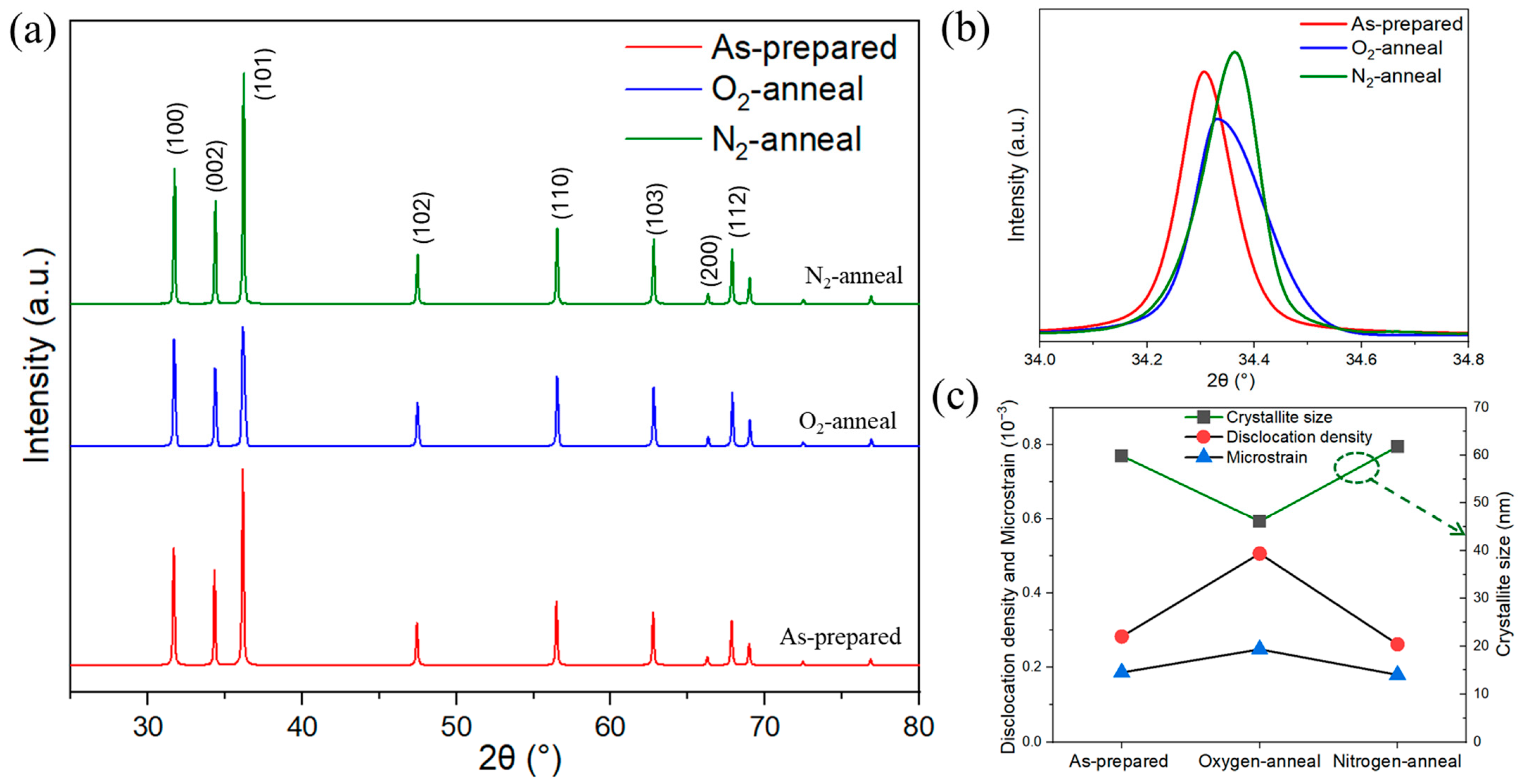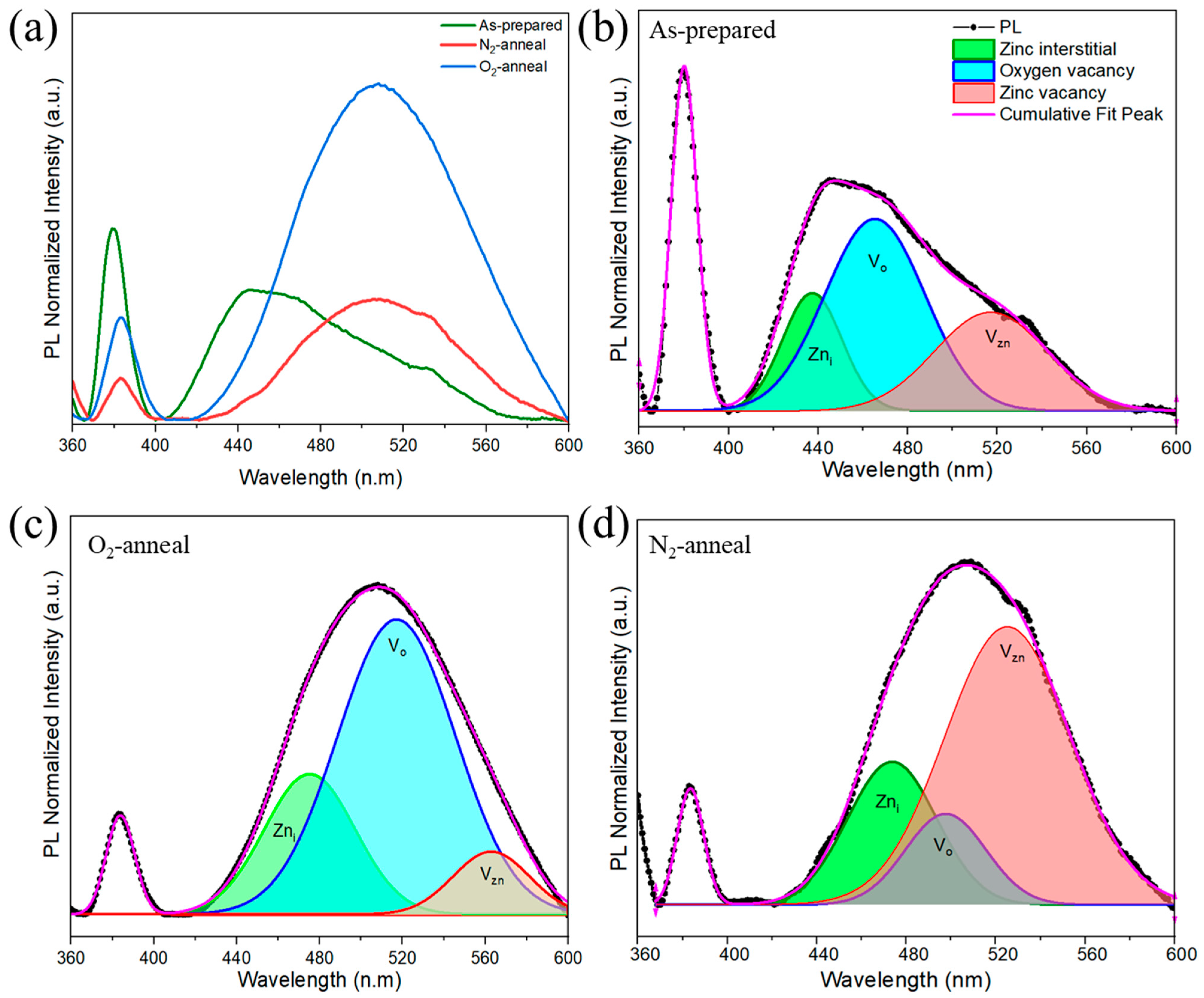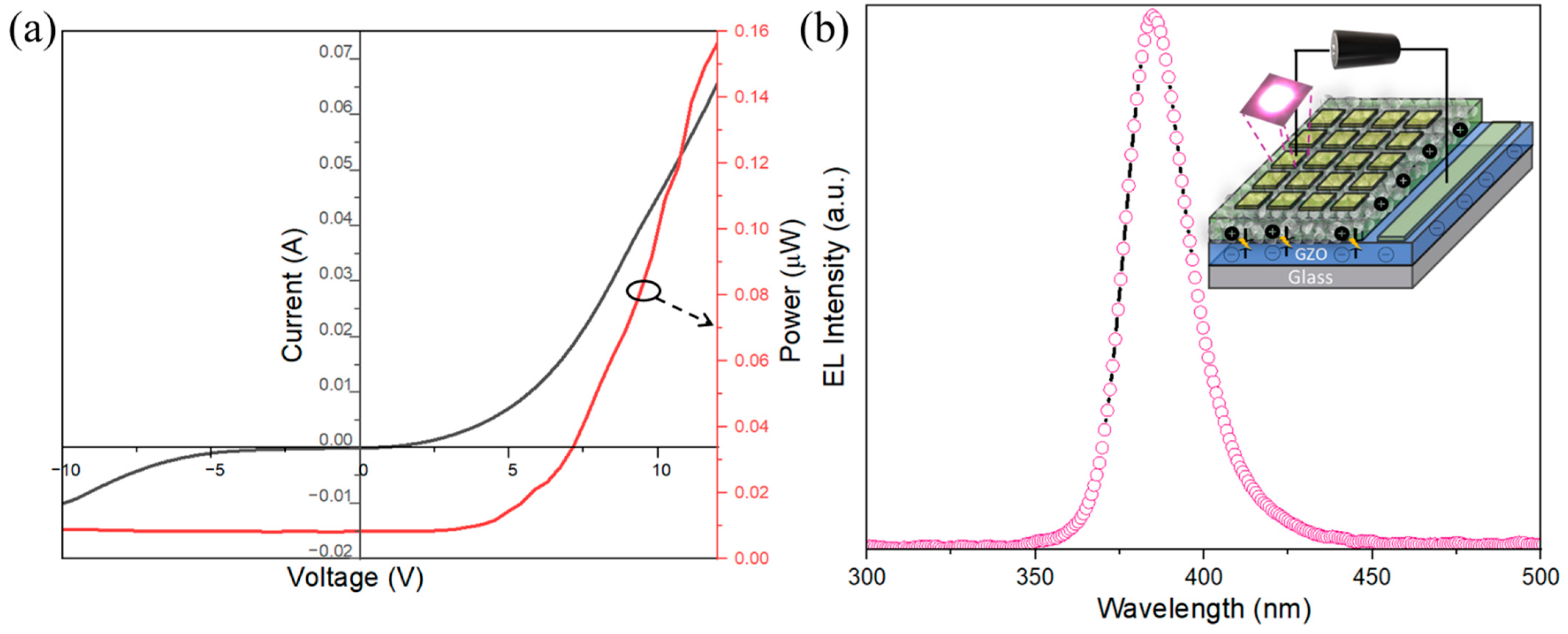Defects in Nitrogen-Doped ZnO Nanoparticles and Their Effect on Light-Emitting Diodes
Abstract
1. Introduction
2. Materials and Methods
3. Results and Discussion
4. Conclusions
Author Contributions
Funding
Data Availability Statement
Acknowledgments
Conflicts of Interest
References
- Mishra, Y.K.; Modi, G.; Cretu, V.; Postica, V.; Lupan, O.; Reimer, T.; Paulowicz, I.; Hrkac, V.; Benecke, W.; Kienle, L.; et al. Direct Growth of Freestanding ZnO Tetrapod Networks for Multifunctional Applications in Photocatalysis, UV Photodetection, and Gas Sensing. ACS Appl. Mater. Interfaces 2015, 7, 14303–14316. [Google Scholar] [CrossRef] [PubMed]
- Uribe-López, M.C.; Hidalgo-López, M.; López-González, R.; Frías-Márquez, D.; Núñez-Nogueira, G.; Hernández-Castillo, D.; Alvarez-Lemus, M. Photocatalytic activity of ZnO nanoparticles and the role of the synthesis method on their physical and chemical properties. J. Photochem. Photobiol. A Chem. 2021, 404, 112866. [Google Scholar] [CrossRef]
- Wolska, E.; Kaszewski, J.; Kiełbik, P.; Grzyb, J.; Godlewski, M.M.; Godlewski, M. Rare earth activated ZnO nanoparticles as biomarkers. Opt. Mater. 2014, 36, 1655–1659. [Google Scholar] [CrossRef]
- Wu, Y.L.; Fu, S.; Tok, A.I.Y.; Zeng, X.T.; Lim, C.S.; Kwek, L.C.; Boey, F.C.Y. A dual-colored bio-marker made of doped ZnO nanocrystals. Nanotechnology 2008, 19, 345605. [Google Scholar] [CrossRef] [PubMed]
- Wang, C.-S.; Lin, H.-Y.; Lin, J.-M.; Chen, Y.-F. Surface-Plasmon-Enhanced Ultraviolet Random Lasing from ZnO Nanowires Assisted by Pt Nanoparticles. Appl. Phys. Express 2012, 5, 062003. [Google Scholar] [CrossRef]
- Zhou, X.; Jiang, M.; Xu, K.; Liu, M.; Sha, S.; Cao, S.; Kan, C.; Shi, D.N. Electrically driven single microwire-based single-mode microlaser. Light Sci. Appl. 2022, 11, 198. [Google Scholar] [CrossRef] [PubMed]
- Liu, M.; Jiang, M.; Zhao, Q.; Tang, K.; Sha, S.; Li, B.; Kan, C.; Shi, D.N. Ultraviolet Exciton-Polariton Light-Emitting Diode in a ZnO Microwire Homojunction. ACS Appl. Mater. Interfaces 2023, 15, 13258–13269. [Google Scholar] [CrossRef] [PubMed]
- Moyen, E.; Kim, J.H.; Kim, J.; Jang, J. ZnO Nanoparticles for Quantum-Dot-Based Light-Emitting Diodes. ACS Appl. Nano Mater. 2020, 3, 5203–5211. [Google Scholar] [CrossRef]
- Weng, W.Y.; Chang, S.J.; Hsu, C.L.; Hsueh, T.J.; Chang, S.P. A Lateral ZnO Nanowire Photodetector Prepared on Glass Substrate. J. Electrochem. Soc. 2010, 157, K30. [Google Scholar] [CrossRef]
- Boruah, B.D.; Mukherjee, A.; Sridhar, S.; Misra, A. Highly Dense ZnO Nanowires Grown on Graphene Foam for Ultraviolet Photodetection. ACS Appl. Mater. Interfaces 2015, 7, 10606–10611. [Google Scholar] [CrossRef]
- Janotti, A.; Van De Walle, C.G. Native point defects in ZnO. Phys. Rev. B 2007, 76, 165202. [Google Scholar] [CrossRef]
- Kim, K.-K.; Niki, S.; Oh, J.-Y.; Song, J.-O.; Seong, T.-Y.; Park, S.-J.; Fujita, S.; Kim, S.-W. High electron concentration and mobility in Al-doped n-ZnO epilayer achieved via dopant activation using rapid-thermal annealing. J. Appl. Phys. 2005, 97, 066103. [Google Scholar] [CrossRef]
- Oh, M.-S.; Hwang, D.-K.; Seong, D.-J.; Hwang, H.-S.; Park, S.-J.; Kim, E.D. Improvement of Characteristics of Ga-Doped ZnO Grown by Pulsed Laser Deposition Using Plasma-Enhanced Oxygen Radicals. J. Electrochem. Soc. 2008, 155, D599. [Google Scholar] [CrossRef]
- Ito, N.; Sato, Y.; Song, P.K.; Kaijio, A.; Inoue, K.; Shigesato, Y. Electrical and optical properties of amorphous indium zinc oxide films. Thin Solid Film. 2006, 496, 99–103. [Google Scholar] [CrossRef]
- Lee, J.; Cha, S.; Kim, J.; Nam, H.; Lee, S.; Ko, W.; Wang, K.L.; Park, J.; Hong, J. p-Type Conduction Characteristics of Lithium-Doped ZnO Nanowires. Adv. Mater. 2011, 23, 4183–4187. [Google Scholar] [CrossRef] [PubMed]
- Liu, W.; Xiu, F.; Sun, K.; Xie, Y.-H.; Wang, K.L.; Wang, Y.; Zou, J.; Yang, Z.; Liu, J. Na-Doped p-Type ZnO Microwires. J. Am. Chem. Soc. 2010, 132, 2498–2499. [Google Scholar] [CrossRef] [PubMed]
- Chu, S.; Wang, G.; Zhou, W.; Lin, Y.; Chernyak, L.; Zhao, J.; Kong, J.; Li, L.; Ren, J.; Liu, J. Electrically pumped waveguide lasing from ZnO nanowires. Nat. Nanotechnol. 2011, 6, 506–510. [Google Scholar] [CrossRef] [PubMed]
- Xiang, B.; Wang, P.; Zhang, X.; Dayeh, S.A.; Aplin, D.P.R.; Soci, C.; Yu, D.; Wang, D. Rational Synthesis of p-Type Zinc Oxide Nanowire Arrays Using Simple Chemical Vapor Deposition. Nano Lett. 2007, 7, 323–328. [Google Scholar] [CrossRef] [PubMed]
- Park, C.H.; Zhang, S.B.; Wei, S.-H. Origin of p-type doping difficulty in ZnO: The impurity perspective. Phys. Rev. B 2002, 66, 073202. [Google Scholar] [CrossRef]
- Lyons, J.L.; Janotti, A.; Van De Walle, C.G. Why nitrogen cannot lead to p-type conductivity in ZnO. Appl. Phys. Lett. 2009, 95, 252105. [Google Scholar] [CrossRef]
- Reynolds, J.G.; Reynolds, C.L.; Mohanta, A.; Muth, J.F.; Rowe, J.E.; Everitt, H.O.; Aspnes, D.E. Shallow acceptor complexes in p-type ZnO. Appl. Phys. Lett. 2013, 102, 152114. [Google Scholar] [CrossRef]
- Liu, L.; Xu, J.; Wang, D.; Jiang, M.; Wang, S.; Li, B.; Zhang, Z.; Zhao, D.; Shan, C.-X.; Yao, B.; et al. p-Type Conductivity in N-Doped ZnO: The Role of the N Zn−VO Complex. Phys. Rev. Lett. 2012, 108, 215501. [Google Scholar] [CrossRef] [PubMed]
- Yuan, G.D.; Zhang, W.J.; Jie, J.S.; Fan, X.; Zapien, J.A.; Leung, Y.H.; Luo, L.B.; Wang, P.F.; Lee, C.S.; Lee, S.T. p-Type ZnO Nanowire Arrays. Nano Lett. 2008, 8, 2591–2597. [Google Scholar] [CrossRef] [PubMed]
- Huang, J.; Chu, S.; Kong, J.; Zhang, L.; Schwarz, C.M.; Wang, G.; Chernyak, L.; Chen, Z.; Liu, J. ZnO p–n Homojunction Random Laser Diode Based on Nitrogen-Doped p-Type Nanowires. Adv. Opt. Mater. 2013, 1, 179–185. [Google Scholar] [CrossRef]
- Chavillon, B.; Cario, L.; Renaud, A.; Tessier, F.; Cheviré, F.; Boujtita, M.; Pellegrin, Y.; Blart, E.; Smeigh, A.; Hammarström, L.; et al. P-Type Nitrogen-Doped ZnO Nanoparticles Stable under Ambient Conditions. J. Am. Chem. Soc. 2012, 134, 464–470. [Google Scholar] [CrossRef] [PubMed]
- NHerring, P.; Panchakarla, L.S.; El-Shall, M.S. P-Type Nitrogen-Doped ZnO Nanostructures with Controlled Shape and Doping Level by Facile Microwave Synthesis. Langmuir 2014, 30, 2230–2240. [Google Scholar] [CrossRef] [PubMed]
- Yang, C.-C.; Lin, C.-C.; Peng, C.-H.; Chen, S.-Y. Effect of annealing atmosphere on physical characteristics and photoluminescence properties of nitrogen-implanted ZnO thin films. J. Cryst. Growth 2005, 285, 96–102. [Google Scholar] [CrossRef]
- Wahyuono, R.A.; Hermann-Westendorf, F.; Dellith, A.; Schmidt, C.; Dellith, J.; Plentz, J.; Schulz, M.; Presselt, M.; Seyring, M.; Rettenmeyer, M.; et al. Effect of annealing on the sub-bandgap, defects and trapping states of ZnO nanostructures. Chem. Phys. 2017, 483–484, 112–121. [Google Scholar] [CrossRef]
- Senthilkumar, K.; Tokunaga, M.; Okamoto, H.; Senthilkumar, O.; Fujita, Y. Hydrogen related defect complexes in ZnO nanoparticles. Appl. Phys. Lett. 2010, 97, 091907. [Google Scholar] [CrossRef]
- Deep, R.; Akazawa, T.; Yoshida, T.; Fujita, Y. A Spectroscopic Evaluation of the Generation Process of Semiconductor Nanoparticles (ZnO) by DC Arc Plasma. J 2023, 6, 207–219. [Google Scholar] [CrossRef]
- Mishra, S.; Witkowski, B.S.; Jakiela, R.; Khosravizadeh, Z.; Paszkowicz, W.; Sulich, A.; Volnianska, O.; Wozniak, W.; Guziewicz, E. Cathodoluminescent Imaging of ZnO:N Films: Study of Annealing Processes Leading to Enhanced Acceptor Luminescence. Phys. Status Solidi A 2023, 220, 2200466. [Google Scholar] [CrossRef]
- Šćepanović, M.; Grujić-Brojčin, M.; Vojisavljević, K.; Bernik, S.; Srećković, T. Raman study of structural disorder in ZnO nanopowders. J. Raman Spectrosc. 2010, 41, 914–921. [Google Scholar] [CrossRef]
- Kaschner, A.; Haboeck, U.; Strassburg, M.; Strassburg, M.; Kaczmarczyk, G.; Hoffmann, A.; Thomsen, C.; Zeuner, A.; Alves, H.R.; Hofmann, D.M.; et al. Nitrogen-related local vibrational modes in ZnO:N. Appl. Phys. Lett. 2002, 80, 1909–1911. [Google Scholar] [CrossRef]
- Wang, J.B.; Zhong, H.M.; Li, Z.F.; Lu, W. Raman study of N+-implanted ZnO. Appl. Phys. Lett. 2006, 8, 101913. [Google Scholar] [CrossRef]
- Friedrich, F.; Gluba, M.A.; Nickel, N.H. Identification of nitrogen and zinc related vibrational modes in ZnO. Appl. Phys. Lett. 2009, 95, 141903. [Google Scholar] [CrossRef]
- Fujita, Y.; Yanase, S.; Nishikori, H.; Hiragino, Y.; Furubayashi, Y.; Lin, J.; Yoshida, T. Near ultraviolet light emitting diodes using ZnMgO:N/ZnO hetero-junction grown by MOVPE. J. Cryst. Growth 2017, 464, 226–230. [Google Scholar] [CrossRef]
- Bandopadhyay, K.; Mitra, J. Zn interstitials and O vacancies responsible for n-type ZnO: What do the emission spectra reveal? RSC Adv. 2015, 5, 23540–23547. [Google Scholar] [CrossRef]
- Shafiqul, I.M.; Deep, R.; Lin, J.; Yoshida, T.; Fujita, Y. The Role of Nitrogen Dopants in ZnO Nanoparticle-Based Light Emitting Diodes. Nanomaterials 2022, 12, 358. [Google Scholar] [CrossRef] [PubMed]
- Tu, Y.; Chen, S.; Li, X.; Gorbaciova, J.; Gillin, W.P.; Krause, S.; Briscoe, J. Control of oxygen vacancies in ZnO nanorods by annealing and their influence on ZnO/PEDOT:PSS diode behaviour. J. Mater. Chem. C 2018, 6, 1815–1821. [Google Scholar] [CrossRef]
- Itohara, D.; Shinohara, K.; Yoshida, T.; Fujita, Y. p-Channel and n-Channel Thin-Film-Transistor Operation on Sprayed ZnO Nanoparticle Layers. J. Nanomater. 2016, 2016, 8219326. [Google Scholar] [CrossRef]
- Shafiqul, I.M.; Deep, R.; Lin, J.; Yoshida, T.; Fujita, Y. Demonstration and Evaluation of p-Type and n-Type ZnO Nanoparticles-Based Homojunction UV Light-Emitting Diodes. Phys. Rapid Res. Lett. 2022, 16, 2100556. [Google Scholar] [CrossRef]







Disclaimer/Publisher’s Note: The statements, opinions and data contained in all publications are solely those of the individual author(s) and contributor(s) and not of MDPI and/or the editor(s). MDPI and/or the editor(s) disclaim responsibility for any injury to people or property resulting from any ideas, methods, instructions or products referred to in the content. |
© 2024 by the authors. Licensee MDPI, Basel, Switzerland. This article is an open access article distributed under the terms and conditions of the Creative Commons Attribution (CC BY) license (https://creativecommons.org/licenses/by/4.0/).
Share and Cite
Deep, R.; Yoshida, T.; Fujita, Y. Defects in Nitrogen-Doped ZnO Nanoparticles and Their Effect on Light-Emitting Diodes. Nanomaterials 2024, 14, 977. https://doi.org/10.3390/nano14110977
Deep R, Yoshida T, Fujita Y. Defects in Nitrogen-Doped ZnO Nanoparticles and Their Effect on Light-Emitting Diodes. Nanomaterials. 2024; 14(11):977. https://doi.org/10.3390/nano14110977
Chicago/Turabian StyleDeep, Raj, Toshiyuki Yoshida, and Yasuhisa Fujita. 2024. "Defects in Nitrogen-Doped ZnO Nanoparticles and Their Effect on Light-Emitting Diodes" Nanomaterials 14, no. 11: 977. https://doi.org/10.3390/nano14110977
APA StyleDeep, R., Yoshida, T., & Fujita, Y. (2024). Defects in Nitrogen-Doped ZnO Nanoparticles and Their Effect on Light-Emitting Diodes. Nanomaterials, 14(11), 977. https://doi.org/10.3390/nano14110977





